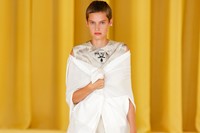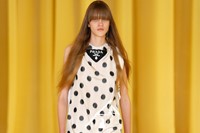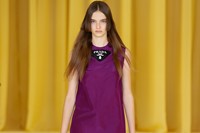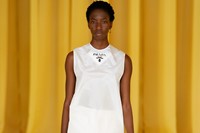On the morning of Simons’ first-ever womenswear collection under his eponymous label, a selection of the Belgian designer’s most illuminating soundbites
For fans of Raf Simons, several news items from the Belgian designer’s camp have sparked joy in a year otherwise marked by doom and gloom. The first came in March, prompting mild hysteria, that Simons and Miuccia Prada would be joining forces as co-creative directors of Prada (the pair revealed their first joint collection last month via a live-streamed runway show). Then, in July, Simons released his Redux collection, giving younger fans the opportunity to buy replicas of 100 seminal pieces from his sought-after archive; and, perhaps most exciting of all – for his female fans at least – last month, he revealed that he would be launching his first-ever womenswear collection under his eponymous label.
Taking place in Antwerp later today, the show coincides with the 25th anniversary of Simons’ brand. Initially trained in industrial design, Simons saw something in 1991 which would alter the course of his life forever: Martin Margiela’s iconic all-white show. “Until then, I still saw fashion as something quite bubbly, not about dialogue or conversation,” he said many years later. “Martin’s show had such an amazing level of emotion and concept. I was crying. A lot of people there were crying … It was like seeing an artwork.’” So moved by this show, Simons’ decided to found his own eponymous label in 1995 and, in the years since, his imaginative and expansive approach to fashion has altered the remit of what menswear can be, bringing it from the sidelines into the fore. With an innate knowledge of subculture and admiration for boldness and pain of youth, Simons’ clothing has, from the start, been imbued with the complexities of masculinity and beauty, life and love. Melding the codes and psyches of different youth cultures – from English schoolboys to Kraftwerk, New Wave and punk – with a romantic obsession with the future, Simons has attracted a dedicated cult following few designers can rival, producing collections which command an emotional pull not dissimilar to his hero, Margiela.
Such an intuitive approach to design has seen the designer soar to success at helm of some fashion’s most prestigious brands, where he has approached womenswear with the same imagination and emotion – from minimalist hero Jil Sander to the historic halls of Dior, American juggernaut Calvin Klein, and now of course at Prada. “For me, there is nothing more satisfying than a woman coming to me and telling me she feels beautiful in my clothes,” Simons told AnOther in 2013. “Isn’t that what most designers aim for? Isn’t that what most designers dream of?” Here, ahead his Spring/Summer 2021 show, a selection of Simons’ most illuminating soundbites on fashion.
- “I don’t want to show clothes, I want to show my attitude, my past, present and future. I use memories and future visions and try to place them in today’s world.”
- “I was really out to find an audience, no matter how small, who could feel, ‘This is something I could connect with, something I feel like I can be part of.’”
- “I’m not so rock and roll. I’m more techno.”
- “In the 90s, it was common to see people who expressed themselves through one designer – the Jil Sander woman, the Martin Margiela woman. You saw her on the street, and you knew who she was.”
- “The future, for me, is romantic, I don’t understand people who say the past is romantic. Romantic, for me, is something you don’t know yet, something you can dream about, something unknown and mystical.”
- “There is always a Martin reference. Hidden or not hidden.”
- “What gives me enormous satisfaction is that we have an incredible following from a young crowd … I don’t know if it is because I understand them or because they understand me. I have always thought – and will never change my mind – that children and kids, youth, are our future. That’s by definition the case, so that’s also why it’s important to pay attention.”
- “Raf Simons is seen as something that is dark, gothic, niche, but I’ve never been interested in just one thing.”
- “The fashion world doesn’t know the word stop, so you have to make sure there are sublime moments every day.”
- “To me, it’s the designer’s responsibility to persuade people to look at other things, to propose what might interest people in the future.”






